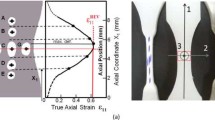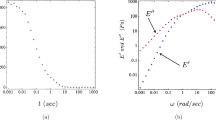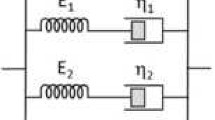Abstract
Many polymer-type materials show a rate-dependent and nonlinear rheological behavior. Such a response may be modeled by using a series of spring-dashpot systems. However, in order to cover different time scales the number of systems may become unreasonably large. A more appropriate treatment based on continuum mechanics will be presented herein. This approach uses representation theorems for deriving material equations and allows for a systematic increase in modeling complexity. Moreover, we propose an approach based on energy to determine thematerial parameters.This method results in a simple linear regression problemeven for highly nonlinearmaterial equations. Therefore, the inverse problem leads to a unique solution. The significance of the proposed method is that the stored and dissipated energies necessary for the procedure are measurable quantities. We apply the proposed method to a “semi-solid” material and measure its material parameters by using a simple-shear rheometer.
Similar content being viewed by others
References
Abali, B.E.: Thermodynamically compatible modeling, determination of material parameters, and numerical analysis of nonlinear rheological materials. Ph.D. thesis, Technische Universität Berlin, Institute of Mechanics (2014)
Abali, B.E.: Supply code, Computational Reality, Technical University of Berlin, Institute of Mechanics, Chair of Continuum Mechanics and Material Theory. http://www.lkm.tu-berlin.de/ComputationalReality/ (2015)
Adkins J.: Symmetry relations for orthotropic and transversely isotropic materials. Archive Ration. Mech. Anal. 4, 193–213 (1959)
Adolf D., Chambers R., Caruthers J.: Extensive validation of a thermodynamically consistent, nonlinear viscoelastic model for glassy polymers. Polymer 45(13), 4599–4621 (2004)
Bird R.B., Wiest J.M.: Constitutive equations for polymeric liquids. Annu. Rev. Fluid Mech. 27(1), 169–193 (1995)
Cho K., Hyun K., Ahn K., Lee S.: A geometrical interpretation of large amplitude oscillatory shear response. J. Rheol. 49(3), 747–758 (2005)
Colby, R.H.: Official symbols and nomenclature of the society of rheology. J. Rheol (1978-present). 57(4) (2013)
Coleman B., Noll W.: The thermodynamics of elastic materials with heat conduction and viscosity. Archive Ration. Mech. Anal. 13(1), 167–178 (1963)
Ewoldt R., Hosoi A., McKinley G.: New measures for characterizing nonlinear viscoelasticity in large amplitude oscillatory shear. J. Rheol. 52(6), 1427–1458 (2008)
Ewoldt R., Winter P., Maxey J., McKinley G.: Large amplitude oscillatory shear of pseudoplastic and elastoviscoplastic materials. Rheologica Acta 49(2), 191–212 (2010)
GNU Public: Gnu general public license. http://www.gnu.org/copyleft/gpl.html (2007)
de Groot S.R., Mazur P.: Non-equilibrium Thermodynamics. Dover Publications, New York (1984)
Hunter J.D.: Matplotlib: a 2d graphics environment. Comput. Sci. Eng. 9(3), 90–95 (2007)
Jou D., Casas-Vazquez J., Lebon G.: Extended irreversible thermodynamics revisited (1988–98). Rep. Prog. Phys. 62(7), 1035–1142 (1999)
Klein C., Spiess H., Calin A., Balan C., Wilhelm M.: Separation of the nonlinear oscillatory response into a superposition of linear, strain hardening, strain softening, and wall slip response. Macromolecules 40(12), 4250–4259 (2007)
McKennell R.: Cone-plate viscometer, comparison with coaxial cylinder viscometer. Anal. Chem. 28(11), 1710–1714 (1956)
Müller I.: The coldness, a universal function in thermoelastic bodies. Archive Ration. Mech. Anal. 41(5), 319–332 (1971)
Müller W.H.: An Excursion to Continuum Mechanics. Springer, Berlin (2014)
Oliphant T.E.: Python for scientific computing. Comput. Sci. Eng. 9(3), 10–20 (2007)
Pobedrya B.E.: Nonlinear viscoelasticity. Mech. Compos. Mater. 1, 18–23 (1965)
Press, W.H., Teukolsky, S.A., Vetterling, W.T., Flannery, B.P.: Numerical recipes in C, vol. 2. Citeseer (1996)
Smith G.: Further results on the strain-energy function for anisotropic elastic materials. Archive Ration. Mech. Anal. 10(1), 108–118 (1962)
Smith G., Rivlin R.: Stress-deformation relations for anisotropic solids. Archive Ration. Mech. Anal. 1(1), 107–112 (1957)
Smith, G., Rivlin, R.: The strain-energy function for anisotropic elastic materials. Transactions of the American Mathematical Society, pp. 175–193 (1958)
Spencer A., Rivlin R.: Further results in the theory of matrix polynomials. Archive Ration. Mech. Anal. 4, 214–230 (1959)
Spencer A.J.M.: Continuum Physics, vol. I—Mathematics. Academic Press, New York and London (1971)
Steffe J.F.: Rheological Methods in Food Process Engineering. Freeman Press, Cambridge (1996)
Strang G.: Linear Algebra and Its Applications. Academic Press, Inc, New York (1980)
Truesdell, C., Toupin, R.A.: Encyclopedia of physics, volume III/1, principles of classical mechanics and field theory, chap. The classical field theories, pp. 226–790. Springer, Berlin/Göttingen/Heidelberg (1960)
Tschoegl N.W.: The phenomenological Theory of Linear Viscoelastic Behavior: An Introduction. Springer, Berlin (1989)
Wilhelm M.: Fourier-transform rheology. Macromol. Mater. Eng. 287(2), 83–105 (2002)
Author information
Authors and Affiliations
Corresponding author
Additional information
Communicated by Andreas Öchsner.
The coauthor C.-C. Wu has written this paper in Technische Universität Berlin.
Rights and permissions
About this article
Cite this article
Abali, B.E., Wu, CC. & Müller, W.H. An energy-based method to determine material constants in nonlinear rheology with applications. Continuum Mech. Thermodyn. 28, 1221–1246 (2016). https://doi.org/10.1007/s00161-015-0472-z
Received:
Accepted:
Published:
Issue Date:
DOI: https://doi.org/10.1007/s00161-015-0472-z




